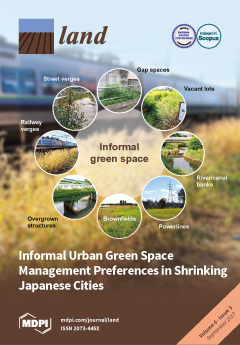Seguridad alimentaría
AGROVOC URI:
Scenarios of Vegetable Demand vs. Production in Brazil: The Links between Nutritional Security and Small Farming
Dietary guidelines urge Brazilians to increase their consumption of raw vegetables. Yet key issues must be tackled by the government and civil society, not only to foster consumers’ appetite for healthier food, but more importantly to diminish the gaps between local demand and production, determined by food and land accessibility. We examine whether vegetable production in Brazil meets the demand to provide Brazilians the daily amount of fresh food recommended by the World Health Organization (WHO).
Efficiency of Conservation Agriculture Production Systems for Smallholders in Rain-Fed Uplands of India: A Transformative Approach to Food Security
With challenges from global climate change, it is imperative to enhance food production using climate-smart technologies and maximize farm efficiency. Fifty-six households in Rudhiapada and Badamahulidiha, Odisha, India were selected to evaluate farmers’ efficiency using conservation agriculture (CA) cropping system practices. Data envelopment analysis (DEA) and regression analysis were used to estimate farmer efficiency and the determinants of yield.
Global Hotspots of Conflict Risk between Food Security and Biodiversity Conservation
The global challenges of food security and biodiversity are rarely addressed together, though recently there has been an increasing awareness that the two issues are closely related. The majority of land available for agriculture is already used for food production, but despite the productivity gains, one in nine people worldwide are classified as food insecure. There is an increasing risk that addressing food insecurity through methods such as agricultural expansion or intensification could lead to biodiversity loss through destruction of habitats important for conservation.
Effect of Climate and Agricultural Land Use Changes on UK Feed Barley Production and Food Security to the 2050s
Currently, the UK has a high self-sufficiency rate in barley production. This paper assessed the effects of projected climate and land use changes on feed barley production and, consequently, on meat supply in the UK from the 2030s to the 2050s. Total barley production under projected land use and climate changes ranged from 4.6 million tons in the 2030s to 9.0 million tons in the 2050s. From these, the projected feed barley supply ranged from approximately 2.3 to 4.6 million tons from the 2030s to the 2050s, respectively.
Land Politics under Market Socialism: The State, Land Policies, and Rural–Urban Land Conversion in China and Vietnam
This paper undertakes a comparative analysis of rural-urban land conversion policies in China and Vietnam, and examines the ideology of the state in land policymaking under a market socialism environment. It argues that land policies in both countries include ambiguous boundaries, which allow the socialist state to legitimize its politico-administrative power in land management and retain strong intervention capacity in the land market.
Expansion of Commercial Sugarcane Cultivation among Smallholder Farmers in Uganda: Implications for Household Food Security
Understanding the impact of commercial agriculture in the face of global change is critical to support strategies that ensure food security and alleviate poverty among households. We assessed the contribution of commercial sugarcane cultivation to household-level food security among smallholder farmers in Busoga sub-region, eastern Uganda. Land use changes are motivated by quick commercial gains rather than sustained food production; a situation that influences food security.
Interactions between Food Security and Land Use in the Context of Global Change
Increases in human population and per-capita consumption are putting enormous pressure on land resources. About 38% of the Earth’s land area is being used in agricultural production [1], with about half (ca. 31%) of the remaining land being under forest cover [2] and the other half being less suitable for agricultural production due to edaphic, topographic and/or climatic factors. Despite the fact that over the last three decades the world food production has doubled [3], about 1 in 9 people in the world is still undernourished [4].
Modelling Land Sharing and Land Sparing Relationship with Rural Population in the Cerrado
Agricultural expansion and intensification enabled growth of food production but resulted in serious environmental changes. In light of that, debates concerning sustainability in agriculture arises on scientific literature. Land sharing and land sparing are two opposite models for framing agricultural sustainability. The first aims to integrate agricultural activities with biodiversity conservation by means of enhancing the quality of the agricultural matrix in the landscape towards a wildlife friendly matrix.
Temporal Dynamics and Motivations for Urban Community Food Gardens in Medium-Sized Towns of the Eastern Cape, South Africa
Urban agriculture is said to be increasing with global urbanization. However, there is little examination of the temporal or spatial dynamics of urban agriculture. We investigated the benefits and challenges experienced by community gardeners in four towns in South Africa, along with GIS analysis of the number, area, and location of urban food community gardens over the last three decades. Common reasons for practicing community gardening were cash poverty (37%) and the need to grow food (34%).
Assessing the Value of Soil Inorganic Carbon for Ecosystem Services in the Contiguous United States Based on Liming Replacement Costs
Soil databases are very important for assessing ecosystem services at different administrative levels (e.g., state, region etc.). Soil databases provide information about numerous soil properties, including soil inorganic carbon (SIC), which is a naturally occurring liming material that regulates soil pH and performs other key functions related to all four recognized ecosystem services (e.g., provisioning, regulating, cultural and supporting services). However, the ecosystem services value, or “true value,” of SIC is not recognized in the current land market.
Beef Cattle Production Systems in South Pantanal: Considerations on Territories and Integration Scales
Pantanal is one of the largest wetlands in the world. In its southern portion, it hosts significant beef cattle ranching, having a herd of 4,832,200 head of cattle in 2016 (IBGE, 2018). Yet it presents intra-regional differences and complementarities. This article discusses such current territory definition, focusing on cattle ranching in Pantanal, considering its forms of occupation, agents, and its intra-regional flow of cattle.







